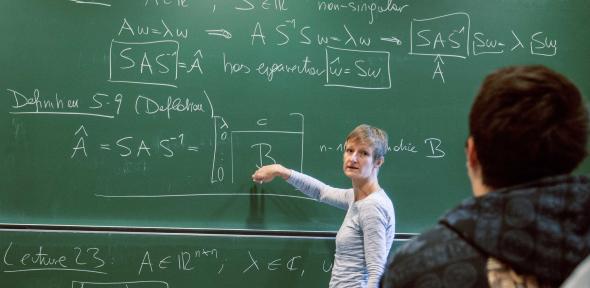
Part III, the final, optional, year of the Cambridge Mathematical Tripos, is one of the oldest taught masters courses in the world. Attracting outstanding students from across the globe, it is renowned for teaching content based on cutting-edge research that may not even have made it into the textbooks yet.
Part III is open to both the highest achieving Cambridge undergraduates and to the best students from around the world. "We take the top third of our undergrads and 10% of the best students from other universities and end up with 250 absolutely top students," says Dr Marj Batchelor from the Department of Pure Mathematics and Mathematical Statistics. "Nowhere else in the country, in the world, compares with this [group of students]."
To the threshold of research
What attracts these students is the unique nature of the course. "It is unique to have such a range of advanced courses across the entirety of mathematics, from the purest parts, to applied mathematics, theoretical physics, statistics and probability," says Prof Colm-cille Caulfield, Chair of the Part III Committee. "There is no other place in the world that offers, year on year, in the order of 70 different courses at a level that is designed to prepare you to be at the threshold of doing research."
The quantum of learning you can have is exceptional. It brings students right up to present research level.Colm-cille Caulfield
The range of courses is decided by the course directors, in conjunction with subject leaders from across the faculty. Although courses vary in response to the interests and research areas of current faculty members, each subject leader ensures a range of courses are available to take the students from undergraduate studies to the beginnings of mathematical research.
"There is a great love in the faculty for Part III," says Prof Imre Leader, the Part III course director for DPMMS. "It's lovely to give a Part III course as you are teaching something close to your own research."
An example is the course Caulfield has taught for the last two years – hydrodynamic stability – which is based on one of his research interests. "I describe it to students as divided into four quarters: the first quarter is what was known when I started my PhD 20 years ago; the second quarter is what was developed in early 90s; the third quarter is what was developed in late 90s and early 2000s; and the fourth quarter is me explaining present research papers from the last few years." The course has been specifically designed to bring students up to speed with new innovations in this area, something that can only be done thanks to the faculty members lecturing on their own research interests. "There's no text book describing the last half of the course – there's barely review articles," says Caulfield.
In your own words
Those students who were Cambridge undergraduates finish Part III with an MMath degree, and those from other universities with an MASt (Masters of Advanced Studies). But their experience of the course is identical. They are free to select any of the 70-odd lecture courses on offer, and then decide which five to eight of these courses they will focus on for their examination. Assessment is entirely based on these exams, apart from an optional essay which typically provides an overview of several recent research papers.
"Nearly all students do the essay and they really love it," says Leader. "They explain recent papers in their own words. The problem can be they are working so hard on their essay when they are supposed to be revising! The essay is their baby and they invest their heart in it."
Producing such an essay was one of the highlights for Miren Radia, a recent Part III student. "Aside from the opportunity to take lots of exciting courses in theoretical physics, I'd probably say the high point of the year was when I completed my essay on black holes. Reading and getting to grips with relatively recent research papers was certainly a rewarding experience though it was also one of the most challenging."
Stacey Law, a recent Part III student, found that giving a seminar about her essay added to the experience: "I took this opportunity to give a seminar and found it helpful to understand the work behind my own essay as I had to speak about it. This was one of my first chances to formally speak about my own work, and both doing it myself and seeing others' talks taught me a lot."
Law, previously a Cambridge undergraduate, saw the Part III course as both a natural extension of her studies and a chance to explore research as a career. "Having already done various internships in software and programming during earlier summers, towards the end of my degree I wanted to try something more along the lines of research to see if it was something I wanted to do further."
Law and Radia are now studying for a PhD at Cambridge, two of the many Part III graduates who are actively courted for research degrees by both our Faculty and universities around the world. "The combination of the breadth and depth that is available in Part III is unique," says Caulfield. "The combined effect of those two quantities means the quantum of learning you can have is exceptional. It brings students right up to present research level."
